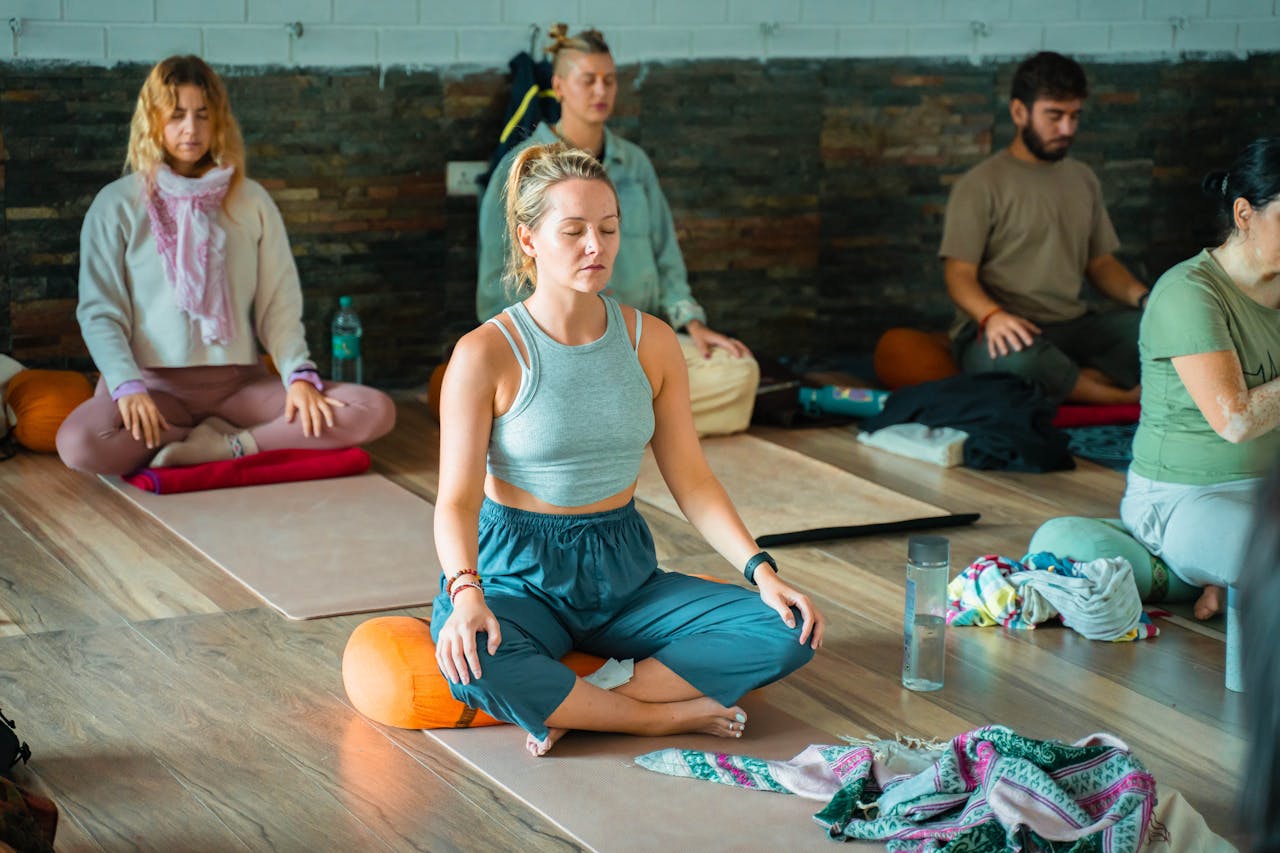
Table of Contents
Body scan meditation is an excellent introduction to mindfulness. This simple mindfulness meditation technique has many benefits.
Body Scan Meditation
Body scan meditation is a simple way to practice mindfulness. Mentally scanning the entire body like an X-ray can improve one's emotional state and the ability to be in the present moment. This Wiki will not diagnose a disease or provide medical advice.
What is Body Scan Meditation?
Body scan meditation is one of the most effective ways to practice mindfulness. The purpose of the practice is to connect the mind to the physical body. Although relaxation is not the primary goal, most practitioners feel calmer during and after meditation.
Different variations of body scan meditations have been around for centuries. It is a style of mindfulness meditation practice that has you focus on the sensations of your body rather than your breath.
Jon Kabat-Zinn’s eight-week mindfulness-based stress reduction (MBSR) program uses the body scan practice to treat long-term illnesses and chronic pain.
According to Kabat-Zinn, doing 20 to 45 minutes of this meditation practice three to six days per week for four weeks will allow you to reap many benefits.
Why do Body Scan Meditations?
Shifting your attention to your body and analyzing it from head to toe can improve your physical and mental state. In addition, it can help you manage stress, pain, and anxiety.
Stress reduction expert Jon Kabat-Zinn recommends the body scan mindfulness exercise as the most effective meditation for pain conditions.
Research suggests that meditation has profound effects on pain management. One randomized study published in the Journal of Behavioral Medicine found that adults with chronic pain can use body scan meditation as a practical and accessible treatment.
After just one session, the 55 participants experienced reduced physical discomfort.
The Health Benefits Of Body Scanning
Body scanning has extensive mental and physical benefits. Here are some of the primary benefits you can expect through regular practice:
- Pain management: According to Harvard Health, practicing a body scan exercise daily for 45 minutes has extensive benefits for living with chronic pain. It will serve you well even if you feel it could be more exciting or helpful. Rather than relieving discomfort completely, the practice aims to make you more familiar with your pain to learn to tolerate and manage it better.
- Improved sleep: Body scan meditation helps improve sleep quality. Several peer-reviewed studies reveal how the technique effectively enables individuals to fall asleep faster, including patients with chronic insomnia. Adequate rest is crucial to health and well-being.
- Stress relief: Body scan techniques allow you to release physical tension in the body. Furthermore, it can improve your bodily awareness and mind-body connections. According to Harvard Health, you can successfully reduce stress and tension by noticing and analyzing build-ups of stress in the body and enhancing bodily awareness.
- Improves overall well-being: Body scan meditation can help people achieve increased psychological well-being. In addition, it can improve symptoms of anxiety and depression. One study analyzed the effectiveness of body scans on healthcare providers who often experience burnout. The results found mindfulness practices that manage stress significantly improve healthcare providers' burnout scores and mental states.
Other helpful benefits you may experience include, but are not limited to:
- Reduced general discomfort
- Increased body awareness
- Improved cardiovascular health
- Reduced inflammation
- More regulated emotions
Practicing Body Scan Meditation
Step 1: Get comfortable
Begin by lying down in a comfortable position. You might like a blanket or pillow behind your head, neck, or knees.
Sitting is also an alternative if you are not in a setting where lying down is an option. Relax your limbs and prepare for the exercise.
Step 2: Take several deep breaths.
Allow your breathing to slow down. Focus on filling your belly with air rather than your chest, known as diaphragmatic breathing.
Notice that your abdomen expands and contracts with each breath, like a balloon inflating and deflating.
Ensure your shoulders are relaxed and do not rise and fall as you breathe. Once you feel ready, take one final deep breath and prepare to begin the body scan.
Step 3: Bring awareness to your feet
Once you are comfortable and relaxed, bring your attention to your feet. You may notice tingling in the soles of the feet.
Observe any other bodily sensations that arise. If you notice any pain or tension, acknowledge this and any thoughts or feelings accompanying it. Gently breathe through it without judgment.
Step 4: Breathe into any noticeable tension.
If you observe any uncomfortable sensations, focus your attention on them. Breathe into the feelings and notice what happens. Visualize the aches, pains, pressure, or tension leaving your body.
Picture the discomfort exiting your body through your breath and evaporating in the air. Move on to the next body part when you feel satisfied and ready.
Step 5: Scan the whole body.
Continue the body scan meditation in each area of your entire body. Gradually move up from the feet through your legs and torso until you reach the crown of your head.
Take notice of where in your body you are holding tension. If you notice pain, pressure, aches, or tightness, continue to breathe into it.
Loving Kindness Meditation
Like the body scan, loving-kindness meditation is another mindfulness practice that reduces stress and physical pain so you can reach a better state of well-being. It is a type of “metta” meditation that manifests positive emotions and fosters love, kindness, and compassion.
If you struggle with the body scan, you can practice loving-kindness with your body scan. As you direct your attention through your body from your toes to the top of your head, use traditional loving-kindness phrases, such as “I love and accept myself,” during periods of silence while connecting to yourself.
Risks And Contraindications
Although there are no real risks and contraindications to body scan meditation, there are some rare side effects that specific individuals experience.
Some of these include an increase in:
- Depression
- Anxiety
- Mania (in rare cases)
However, most individuals who practice body scan meditation experience an improvement in their mental health. If you feel a decline in mental health following body scan practice, it may not be the best mindfulness exercise.
Frequently Asked Questions
Is the body scan considered mindfulness?
Yes, body scan techniques are a form of meditation and mindfulness practice. Rather than focusing on the breath, as done in most mindfulness and yoga exercises, you will focus on bodily sensations.
Tuning into the body and connecting with the physical self will improve your mindfulness, concentration, and awareness. You will reap many benefits if you incorporate body scans into your daily life and commit yourself to the practice.
Is Yoga Nidra a body scan meditation?
Yoga Nidra is a guided meditation that has you scan your body as the first step in the process. It brings mindful awareness to different body parts to help you achieve deep relaxation.
The guided meditation brings practitioners into a state where bodies can rest while the mind remains conscious. The body scan process resets the nervous system and energizes the mind and body.
Are body scan meditations good for sleep?
Yes, body scan meditations are great for helping you fall asleep at night. As you take notice of your body, you can notice where you are tense and begin to let go of your stress, which will prepare you for rest and help to improve your overall sleep quality.
References
7 Benefits of Meditation and How It Can Affect Your Brain.
How mindfulness changed my sleep
Mindfulness meditation to control pain - Harvard Health.
How to Practice Loving Kindness Meditation.
Why and How to Do a Mental Body Scan for Stress Relief.
Six relaxation techniques to reduce stress - Harvard Health.
Disclaimer
The contents of this article are provided for informational purposes only and are not intended to substitute for professional medical advice, diagnosis, or treatment. It is always recommended to consult with a qualified healthcare provider before making any health-related changes or if you have any questions or concerns about your health. Anahana is not liable for any errors, omissions, or consequences that may occur from using the information provided.

By: Meriah McCauley
Meriah McCauley is passionate about the art and science of holistic health and healing. She explored the power of yoga through working with her mentor and guru Dr. Don Stapleton in Costa Rica. She also received a Masters in Psychology from Columbia University, specializing in Spirituality and the MindBody connection. Meriah now offers coaching, yoga teacher trainings, and Holotropic Breathwork for personal development. She loves to connect with those on this path.
